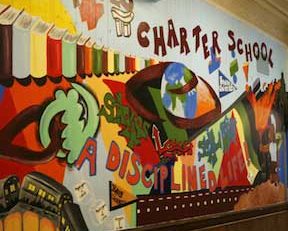Charter schools are primary or secondary schools that receive public money (and like other schools, may also receive private donations) but are not subject to some of the rules, regulations, and statutes that apply to other public schools in exchange for some type of accountability for producing certain results, which are set forth in each school’s charter.
Charter schools are opened and attended by choice. While charter schools offer an alternative to other public schools, they are part of the public education system and are not allowed to charge tuition. Where enrollment in a charter school is oversubscribed, admission is frequently distributed by lottery-based admissions systems. However, the lottery is open to all students. In a 2008 survey of charter schools, 59% of the schools reported that they had a waiting list, averaging 198 students. Some charter schools provide a curriculum that specializes in a certain field, e.g., arts, mathematics, or vocational training. Others aim to provide a better and more efficient general education than nearby public schools. Charter school students take state-mandated exams.
Some charter schools are founded by teachers, parents, or activists who feel limited by traditional public schools. State-authorized charters (schools not chartered by local school districts) are often established by non-profit groups, universities, and some government entities. Additionally, school districts sometimes allow corporations to manage chains of charter schools. The schools themselves are still non-profit, in the same way that public schools may be managed by a for-profit corporation. It does not change the status of the school. In the United States, though the percentage of students educated in charter schools differs by school district, only in the New Orleans Public Schools system are the majority of children educated within independent public charter schools.
History
The charter school idea in the United States was originated by Ray Budde, a professor at the University of Massachusetts Amherst and supported by Albert Shanker, President of the American Federation of Teachers, in 1988 when he called for the reform of the public schools by establishing “charter schools” or “schools of choice”. At the time, a few schools already existed that were not called charter schools but embodied some of their principles, such as H-B Woodlawn. As originally formed, the ideal model of a charter school was as a legally and financially autonomous public school (without tuition, religious affiliation, or selective student admissions) that would operate much like a private business—free from many state laws and district regulations, and accountable more for student results rather than for processes or inputs (such as Carnegie Units and teacher certification requirements).
Minnesota was the first state to pass a charter school law in 1991. California was second, in 1992. As of 2009, 41 states and the District of Columbia have charter school laws.

